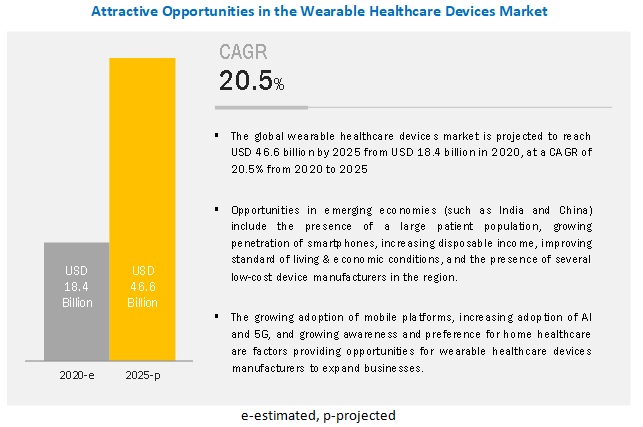
According to research report wearable healthcare devices market size is projected to reach USD 46.6 billion by 2025 from USD 18.4 billion in 2020, at a CAGR of 20.5% from 2020 to 2025.
Download PDF Brochure: https://www.marketsandmarkets.com/pdfdownloadNew.asp?id=81753973
This market is largely driven by the increasing awareness of fitness and healthy lifestyles, development of technologically advanced products, growing geriatric population and subsequent increase in the incidence of chronic diseases, cost-containment in healthcare delivery, robust penetration of 3G and 4G networks for uninterrupted healthcare services, increasing penetration of smartphones and the growing number of smart-phone based healthcare apps and growing preference for wireless connectivity among healthcare providers are driving the growth of the global wearable healthcare devices industry. Growing adoption of mobile platforms, increasing adoption of AI and 5G, and the growing awareness & preference for home healthcare are opening opportunities for the growth of the market.
Based on device type, the wearable healthcare devices market is segmented into diagnostic & monitoring devices and therapeutic devices. In 2019, the diagnostic & monitoring devices segment accounted for a larger share of 64.3% of the wearable healthcare devices market. The large share of this segment can be attributed to factors such as the growing prevalence of chronic & lifestyle diseases, the availability of technologically advanced and compact products that can be easily worn, the ability of diagnostic & monitoring devices to diagnose multiple health conditions at relatively earlier stages, and the increasing accuracy of the products.
Based on applications, the wearable healthcare devices market is segmented into general health and fitness, remote patient monitoring, and home healthcare applications. In 2019, the general health and fitness segment accounted for the largest share of the market, primarily due to the increasing focus on physical fitness among people to improve their quality of life, coupled with the growing trend of tracking health progress on a continuous basis.
Based on the distribution channel, the wearable healthcare devices market is segmented into pharmacies, online channels, and hypermarkets. Pharmacies accounted for the largest share of 46.7% of the global wearable healthcare devices market in 2019. The increasing trend of self-monitoring and non-invasive monitoring and diagnosis has resulted in a substantial increase in the supply of wearable devices in pharmacies.
Based on region, the global wearable healthcare devices market is segmented into North America, the Asia Pacific, Europe, Latin America, and the Middle East & Africa. In 2019, North America accounted for the largest share of 38.0% of the global wearable healthcare devices market.
Get Report Sample: https://www.marketsandmarkets.com/requestsampleNew.asp?id=81753973
The major players in the wearable healthcare devices market are Medtronic plc. (Ireland), Koninklijke Philips N.V. (Netherlands), OMRON Corporation (Japan), Biotelemetry Inc.(US), Apple, Inc. (US), Dexcom Inc. (US), Abbott Laboratories(US), Masimo Corporation(US), GE Healthcare(US), Bio-Beat Technologies (Israel), iRhythm Technologies, Inc. (US), VitalConnect (US), Minttihealth (US), Preventice Solutions, Inc. (US), CONTEC Medical Systems Co. Ltd (China), Biotricity Inc.(US), Verily Life Sciences.(US), Cyrcadia Asia Limited (Hong Kong ), ten3T healthcare (India), Fitbit, Inc. (US), Garmin Ltd (Switzerland), Xiaomi Technologies (China), and Huawei Corporation (China).